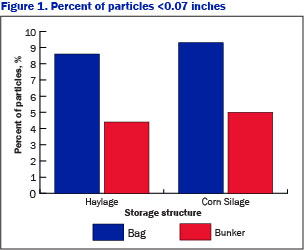
The “fine” details on silage storage and particle size – Margaret Quaassdorff, Vita Plus
 By Margaret Quaassdorff, Vita Plus Lake Mills dairy specialist
By Margaret Quaassdorff, Vita Plus Lake Mills dairy specialistAlthough some debate over the exact cut-off length exists, it’s clear that large particles (greater than 0.75 inches) consumed in the diet contribute to the floating rumen mat and encourage rumination. While other nutritionists have noted differences in the percentage of these large particles in the top sieve of the four-part Penn State Particle Separator, our survey showed little difference between corn silage stored in bags versus bunkers and piles with only subtle differences in haylage stored in those structures.

Our field study showed, on average, haylage and corn silage stored in bags had nearly double the amount of fine particles (less than 0.07 inches) in the bottom pan compared to bunkers. This means, on average, at least 8.6 percent of haylage particles and 9.3 percent of corn silage particles pass through the rumen without contributing to rumination stimulation – a lot of ineffective particles compared to the 5.0 percent or less guideline for fine particles.
If a diet is not “physically” balanced, possibly due to forages contributing greater than 5.0 percent particles of 0.07 inches or less, inadequate fiber could lower the rumen pH, creating an environment with inefficient fiber digesting rumen microbes and decreased dairy cow health and production. A lower rumen pH may also be associated with subacute rumen acidosis and milkfat depression. This increases the potential for reduced dry matter intake (DMI) and the chances of displaced abomasum, laminitis, and hemorrhagic bowel syndrome – one big mess! In contrast, too much fiber in the diet may displace more digestible nutrients and contribute to reduced DMI via gut fill.
Overall, when balancing diets, consider both the nutrient content and the physical properties of forages. Be sure to track the physical properties of your forages because they may change depending on storage structure and perform differently for your herd.
| Category: |
Facility design Feed quality and nutrition Forage Foundations Forage storage and management |

